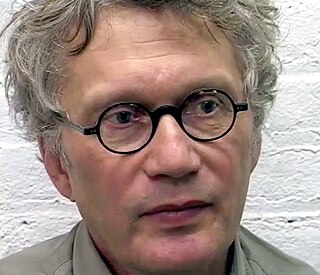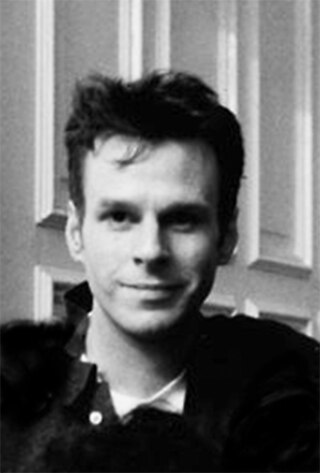G. H. Hovagimyan is an American experimental cross-media, new media art and performance artist who lives and works in New York City.

Cabinet Magazine is a quarterly, Brooklyn, New York–based, non-profit art and culture magazine established in 2000. Cabinet Magazine also operates an event and exhibition space in Brooklyn. In 2022, Cabinet transitioned its magazine to be a digital publication, although it still publishes print books.
William Roger Welch is an American conceptual artist, installation artist and video artist.
Nachume Miller (1949–1998) was an Israeli artist who immigrated to New York City in 1973, where he made a name for himself in the American Modern Art scene. Miller's parents were both Holocaust survivors. His father was a captain in the front lines of the Russian Army during World War II and his mother was a Lithuanian who had once been held captive in a concentration camp. Both escaped the Nazis, re-united and fled to Israel. Nachume was born during their voyage, in Frankfurt, Germany, on January 28, 1949. He grew up in the town of Holon, Israel, where he was inspired by his father who spent most of his post-war days carving elaborate wood sculptures of Cubist human forms. Nachume, on the contrary, excelled in painting.
![<span class="mw-page-title-main">FOOD (New York restaurant)</span> Artisanal restaurant in [[SoHo]]](https://upload.wikimedia.org/wikipedia/en/thumb/9/91/Street_view_of_FOOD_%28New_York_restaurant%29.jpg/320px-Street_view_of_FOOD_%28New_York_restaurant%29.jpg)
FOOD was an artist-run restaurant in SoHo, New York. FOOD was founded by artists Carol Goodden, Tina Girouard and Gordon Matta-Clark. FOOD was considered one of the first important restaurants in SoHo. Other individuals who were involved with FOOD included Suzanne Harris and Rachel Lew. FOOD was a place where artists in SoHo, especially those who were later involved in Avalanche magazine and the Anarchitecture group, could meet and enjoy food together. FOOD was considered to be both a business and an artistic "intervention in an urban setting." It has also been called a "landmark that still resonates in the history and mythology of SoHo in the 1970s."
An alternative exhibition space is a space other than a traditional commercial venue used for the public exhibition of artwork. Often comprising a place converted from another use, such as a store front, warehouse, or factory loft, it is then made into a display or performance space for use by an individual or group of artists. According to art advisor Allan Schwartzman "alternative spaces were the center of American artistic life in the '70s."
Art International Radio was an online, non-profit, cultural Internet radio station and home to the Clocktower Gallery, a historic New York City alternative exhibition space. Art International Radio was directed by Alanna Heiss, the founder and former Director of P.S.1 Contemporary Art Center in Long Island City, Queens.

Lutz Bacher was an artist closely associated with Berkeley, California since the 1970s, and who lived and worked in New York City from 2013 until her death The name Lutz Bacher was a pseudonym, and the artist did not publicly reveal a former name. She was once considered a figure with "cult" status—known for being "legendary but elusive" in the California art scene. Since the early 2000s, her work increasingly gained mainstream recognition.
Martha Wilson is an American feminist performance artist and the founding director of Franklin Furnace Archive art organization. Over the past four decades she has developed and "created innovative photographic and video works that explore her female subjectivity through role-playing, costume transformation, and 'invasions' of other peoples personas". She is a recipient of two National Endowment for the Arts fellowships, a New York Foundation for the Arts fellowship, and an Obie Award and a Bessie Award for commitment to artists’ freedom of expression. She is represented by P•P•O•W gallery in New York City.

The Walther Collection is a private non-profit organization dedicated to researching, collecting, exhibiting, and publishing modern and contemporary photography and video art. The collection has two exhibition spaces: the Walther Collection in Neu-Ulm/Burlafingen, in Germany, and the Walther Collection Project Space in New York City.

Bill Beckley is an American narrative and conceptual artist.
Holly Solomon (1934–2002) was an American collector of contemporary art and founder of the Holly Solomon Gallery in New York City in 1975. Her SoHo, Manhattan gallery was initially known for nurturing the artistic movement known as Pattern and Decoration, which was a reaction to the austerities of Minimal art. She was the subject of an early portrait by Andy Warhol that made her a Pop Art icon, of sorts, as well as the subject of portraits by Roy Lichtenstein and Robert Rauschenberg. Holly and Horace Solomon made a lasting contribution to the work of Gordon Matta-Clark when they provided the site for Matta-Clark's project Splitting, a suburban home in Englewood, New Jersey.
Holly Solomon Gallery opened in New York City in 1975 at 392 West Broadway in Soho, Manhattan. Started by Holly Solomon - aspiring actress, style-icon, and collector - and her husband Horace Solomon, the gallery was initially known for launching major art careers and nurturing the artistic movement known as Pattern and Decoration, which was a reaction to the austerities of Minimal art.
Cynthia Marie "Tina" Girouard was an American video and performance artist best known for her work and involvement in the SoHo art scene of the 1960s and early 1970s.
Thomas Solomon is an American art dealer and curator who owns the Thomas Solomon Gallery in Los Angeles. Considered a "leading figure" in the Los Angeles art world, he represents 1960s and 1970s conceptual and emerging artists. He also provides art consulting services through Thomas Solomon Fine Art Advising. He is the son of New York City art collectors and patrons Horace and Holly Solomon.
Carol Goodden is a New York based artist and dancer known for her photography and participation in Trisha Brown's dance company. She was also the co-founder of the artist-run restaurant, FOOD where she was the main investor.
Douglas Melini is a New York City and New Jersey based American painter and a CalArts alumnus.

Glen Seator (1956-2002) was an American visual artist and conceptual sculptor. He lived in Brooklyn, NY and San Miguel de Allende, Mexico.
NIAD Art Center is a 501(c)(3) organization for artists with developmental and physical disabilities, founded in 1982 and based in Richmond, Contra Costa County, California. The organization provides studios, supplies, and gallery space.
Willa Nasatir is an American visual artist and photographer. In 2017, Nasatir presented a solo exhibition at the Whitney Museum organized by Jane Panetta.


![<span class="mw-page-title-main">FOOD (New York restaurant)</span> Artisanal restaurant in [[SoHo]]](https://upload.wikimedia.org/wikipedia/en/thumb/9/91/Street_view_of_FOOD_%28New_York_restaurant%29.jpg/320px-Street_view_of_FOOD_%28New_York_restaurant%29.jpg)



